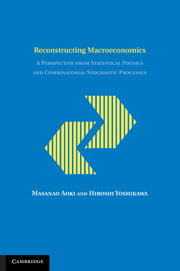 Reconstructing Macroeconomics
Reconstructing Macroeconomics Book contents
- Frontmatter
- Contents
- Preface by Masanao Aoki
- Preface by Hiroshi Yoshikawa
- 1 Introduction: A New Approach to Macroeconomics
- 2 The Methods: Jump Markov Process and Random Partitions
- 3 Equilibrium as Distribution: The Role of Demand in Macroeconomics
- 4 Uncertainty Trap: Policy Ineffectiveness and Long Stagnation of the Macroeconomy
- 5 Slow Dynamics of Macro System: No Mystery of Inflexible Prices
- 6 Business Cycles: An Endogenous Stochastic Approach
- 7 Labor Market: A New Look at the Natural Unemployment and Okun's Law
- 8 Demand Saturation-Creation and Economic Growth
- 9 The Types of Investors and Volatility in Financial Markets: Analyzing Clusters of Heterogeneous Agents
- 10 Stock Prices and the Real Economy: Power-Law versus Exponential Distributions
- References
- Author Index
- Subject Index
- Other books in the series (continued from page iii)
1 - Introduction: A New Approach to Macroeconomics
Published online by Cambridge University Press: 08 August 2009
- Frontmatter
- Contents
- Preface by Masanao Aoki
- Preface by Hiroshi Yoshikawa
- 1 Introduction: A New Approach to Macroeconomics
- 2 The Methods: Jump Markov Process and Random Partitions
- 3 Equilibrium as Distribution: The Role of Demand in Macroeconomics
- 4 Uncertainty Trap: Policy Ineffectiveness and Long Stagnation of the Macroeconomy
- 5 Slow Dynamics of Macro System: No Mystery of Inflexible Prices
- 6 Business Cycles: An Endogenous Stochastic Approach
- 7 Labor Market: A New Look at the Natural Unemployment and Okun's Law
- 8 Demand Saturation-Creation and Economic Growth
- 9 The Types of Investors and Volatility in Financial Markets: Analyzing Clusters of Heterogeneous Agents
- 10 Stock Prices and the Real Economy: Power-Law versus Exponential Distributions
- References
- Author Index
- Subject Index
- Other books in the series (continued from page iii)
Summary
In his 1844 essay, “On the Influence of Consumption upon Production,” J. S. Mill endeavored to refute the belief that, “A great demand, a brisk circulation, a rapid consumption (three equivalent expressions) are a cause of national prosperity.” In this book, we take up the old belief and propose that aggregate demand does matter in the determination of total output. The argument requires a drastic turn in macroeconomic, theory and introduces new methods. The purpose of this book is to explain the new approach. Readers will see how new methods and concepts broaden the scope of macroeconomics and shed new light on old problems such as demand deficiency, inflexible prices, business cycles, and asset prices.
The idea that demand matters was, of course, established by Keynes (1936) – indeed, macroeconomics used to be synonymous with Keynesian economics. Alas, no more! Keynes' principle of effective demand – that aggregate demand determines the level of aggregate production or output – is in stark contrast to the neoclassical doctrine that aggregate output is determined solely by supply factors such as factor endowments and technology, and that demand is relevant only with respect to composition of outputs. Despite its empirical attractiveness, Keynesian economics has long been charged with lacking microeconomic foundations. The need for microeconomic foundations meant that the optimization of agents had to be explicitly considered in models.
Many economists have come to believe that the first principle of economics is the optimization of economic agents such as household and firm.
Information
- Type
- Chapter
- Information
- Reconstructing MacroeconomicsA Perspective from Statistical Physics and Combinatorial Stochastic Processes, pp. 1 - 27Publisher: Cambridge University PressPrint publication year: 2006